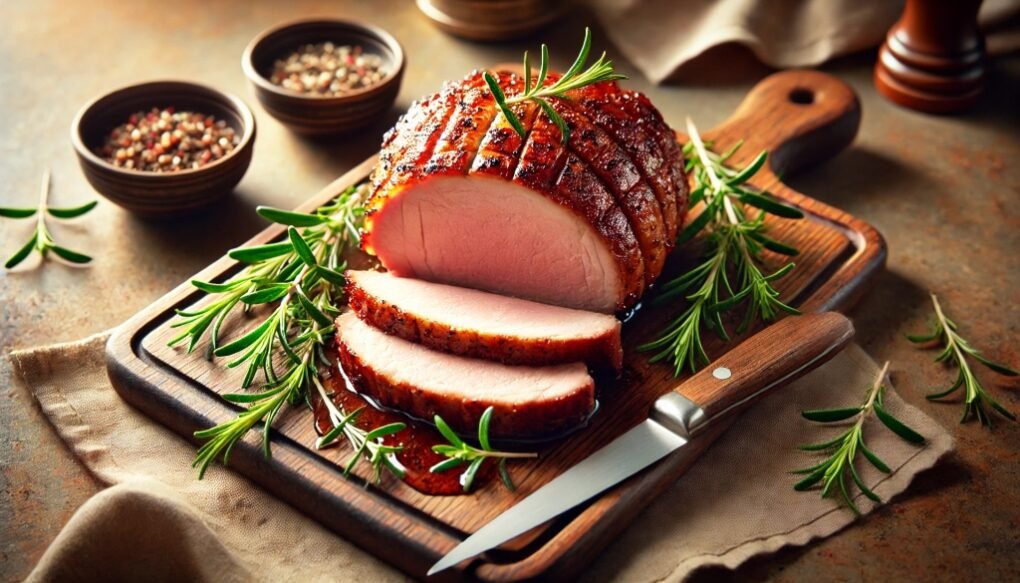Cooking pork loin to the right internal temperature is crucial for both flavor and safety. Whether you’re a novice or a seasoned chef, knowing the correct internal temp of pork loin can make the difference between a juicy, tender dish and a dry, overcooked one. In this comprehensive guide, we will walk you through everything you need to know about cooking pork loin, from the ideal internal temperature to tips on how to achieve perfect results every time.
What is Pork Loin?
Pork loin is a lean, tender cut of meat that comes from the pig’s back. It is different from pork tenderloin, which is a smaller, more slender cut from the same general area. Pork loin is often sold in larger portions and is typically roasted or grilled. Its mild flavor pairs well with various seasonings, making it a versatile choice for family dinners, special occasions, or even meal prep.
Why Internal Temperature Matters
When cooking pork, the internal temperature is key to ensuring the meat is cooked through while remaining juicy. Undercooked pork can pose health risks due to harmful bacteria such as Trichinella spiralis, while overcooked pork becomes dry and tough.
To guarantee a delicious result, it’s important to aim for the right internal temperature based on how you plan to serve the pork loin.
Recommended Pork Loin Internal Temperature
The USDA recommends cooking pork to an internal temperature of 145°F (63°C) followed by a three-minute rest period. This temperature allows for a slight pink center, which is perfectly safe to eat and ensures the meat stays tender and moist.
Here’s a breakdown of what to expect at different temperature points:
- 145°F (63°C) – Juicy, tender pork with a slight blush of pink.
- 150-155°F (66-68°C) – Cooked throughout with minimal pink, slightly firmer texture.
- 160°F (71°C) and above – Fully cooked, with no pink; however, the texture may be on the dry side.
Always use a meat thermometer to accurately gauge the internal temp of pork loin. Insert the probe into the thickest part of the meat, making sure to avoid touching any bones, which can give a false reading.
How to Check the Internal Temperature of Pork Loin
1. Using a Meat Thermometer
Invest in a reliable meat thermometer for best results. Instant-read thermometers provide quick, accurate readings. When using the thermometer, make sure to check the temperature at multiple spots to ensure even cooking throughout the meat.
2. Resting the Pork Loin
After reaching the desired temperature, remove the pork from the heat source and allow it to rest for 3-5 minutes. This resting period lets the juices redistribute within the meat, locking in moisture and enhancing flavor. While resting, the internal temperature may rise slightly, so it’s okay to pull the meat from the heat when it’s a few degrees shy of the target.
Cooking Methods to Reach the Perfect Internal Temp
Different cooking methods can help you achieve the ideal pork loin internal temperature. Below are some popular methods:
Grilling Pork Loin
Grilling is a popular option for pork loin. To grill pork loin properly, start by preheating the grill to medium heat, around 350°F (175°C). Place the pork loin on the grill and cook until the internal temperature reaches 140°F (60°C). Remove it from the grill, then let it rest for three minutes as the temperature rises to 145°F (63°C).
Roasting Pork Loin
Roasting pork loin is another easy way to cook this cut of meat. Preheat the oven to 350°F (175°C). Season the pork loin with your preferred spices and place it in a roasting pan. Roast until the internal temperature reaches 140°F (60°C), then remove and allow it to rest, bringing the final temp up to 145°F (63°C).
Sous Vide Pork Loin
Sous vide cooking involves vacuum-sealing the pork loin and submerging it in a water bath at a consistent temperature. For a medium-rare pork loin, set your sous vide to 140°F (60°C) and cook for 1.5 to 2 hours. Afterward, sear the pork in a hot skillet for a crispy exterior before serving.
Common Mistakes to Avoid When Cooking Pork Loin
Cooking pork loin might seem straightforward, but a few common mistakes can prevent you from achieving the perfect result. Here’s what to watch out for:
Overcooking the Pork Loin
It’s easy to overcook pork loin, especially if you don’t use a meat thermometer. Always rely on internal temperature rather than cooking time. Pull the pork off the heat source once it reaches the ideal internal temperature.
Not Resting the Meat
Skipping the rest period after cooking can cause the juices to run out when the meat is cut, leading to dry pork. Let the pork loin rest for 3-5 minutes before slicing.
Cooking Straight from the Fridge
Allow the pork loin to come to room temperature before cooking. If it’s too cold, the outside may overcook while the inside remains undercooked.
Flavoring Tips for Pork Loin
Seasoning pork loin well can elevate its flavor, complementing the juicy texture you get from cooking it to the right internal temp. Here are some flavoring tips to enhance your pork loin dish:
Marinades
Marinating pork loin helps to infuse it with flavor and moisture. Common marinades include a blend of olive oil, garlic, rosemary, and lemon juice.
Dry Rubs
If you prefer a dry rub, use spices such as paprika, cumin, garlic powder, and black pepper. Dry rubs create a flavorful crust on the pork loin when roasted or grilled.
Sauces
Pair your cooked pork loin with sauces like apple chutney, mustard glaze, or a classic gravy. These sauces add richness and balance to the savory flavor of the pork.
Resting and Serving
Once your pork loin has reached the desired internal temperature and has rested for a few minutes, it’s ready to be served. Slice the pork against the grain for the most tender cuts. Serve it alongside roasted vegetables, mashed potatoes, or a fresh salad.
Final Thoughts on Pork Loin Internal Temp
Achieving the perfect pork loin internal temp is the secret to juicy, flavorful meat that everyone will love. By following the USDA guidelines and using a meat thermometer, you can avoid common cooking mistakes and ensure that your pork loin comes out perfectly cooked every time. Whether you’re grilling, roasting, or using sous vide, remember to let the pork rest before serving to maximize its juiciness.









